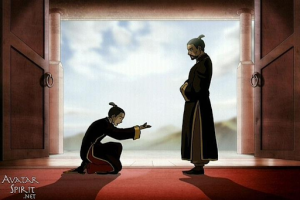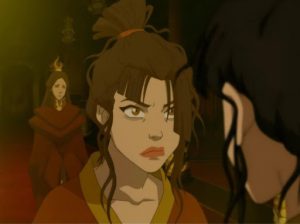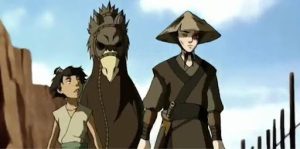27
Diversity, Power, and Discrimination in Avatar: The Last Airbender (2005-2008)
By Bryan D. Mastenbrook
Avatar: The Last Airbender is a traditionally animated television series that ran from 2005 to 2008. Being an animated show, some may assume that it is nothing more than children’s amusement. However, the show is quick to dive into deep and mature topics, with episode 3 being where the main character Aang discovers that his people the airbenders were victims of genocide and that he is the last of them. What makes Avatar: The Last Airbender so memorable is its ability to tell adult stories with weighty topics like genocide in a context that even children can understand. By doing this, it brings together generations and teaches good values like respecting others and treating others kindly to the youngest among us. This show has been a major influence on my life, and without a doubt, I can say it has pushed me towards the good.
The world of Avatar: The Last Airbender features four countries. The Water Tribes are tribes at the north and south poles who are loosely based on the Inuit people. The Earth Kingdom is a large and diverse nation reminiscent of ancient China that is highly decentralized. The Fire nation is based on Imperial Japan, and they have been at war with the other nations for a century. The Air Nomads were a Tibetan like people eliminated save one, by the Fire Nation at the start of the war. None of these countries are based on western nations, and this gives the show its very Asiatic world. Each nation is named after one of the four elements classically thought to be the building blocks of the world, and certain members of each nation have the ability to manipulate or bend their element. The exception is the reincarnating Avatar who can bend all four elements. Avatar: The Last Airbender is in many ways based on World War II. The nations based on Japan and China are in a bitter war, and the fascist instigator of war is responsible for genocide.
The fantasy setting of Avatar: The Last Airbender allows difference to be seen in a unique way, benders vs non-benders. Having quasimagical powers make benders inherently more valuable to each nation. The main cast of heroes features a bender of each element, and Sokka a nonbender. As each bender improved their ability, Sokka became comparatively less useful in combat, and for a show set during a war, this becomes a big issue. Sokka feels emasculated and powerless, and so he seeks to become more powerful in the episode Sokka’s Master. While traveling disguised they happen upon a village that is home to the master swordsman Piandao. Sokka is accepted and trained by Piandao but becomes ashamed of misrepresenting himself. When he reveals that he is from the Water Tribe Piandao duels Sokka and shows him and the audience how much he has learned and grown. Piandao reveals that he knew who Sokka was from the beginning and that the ways of the sword belong to no nation. Despite being from different nations there exists solidarity among nonbenders in the Avatar world. The events of this episode remind me of the introduction to the section in class in which it says “Seemingly in response to this implied criticism (less economically successful men are somehow inadequate), many economically struggling groups in the United States place a heavy importance on strength and ability” (Benshoff, Harry). While the text is in this case dealing with ability to earn money what it says about emasculation can also apply to men who feel they lack the ability to defend themselves.

Opposite of Sokka is Azula, as she is gifted too much power and abuses it. She is a princess of the Fire Nation, and a gifted firebender with her signature blue flames. She is introduced later in the series and acts as a foil to her older and less talented brother Zuko who has been one of the main antagonists. Both have the goal of capturing the Avatar, and this fuels their sibling rivalry. Azula uses power and intimidation to get whatever she wants, and this destroys her in the end. In the episode The Boiling Rock, Part 2 Azula is prevented from ending the life of her brother by her ally and his love interest Mai who says that she loves Zuko more than she fears Azula. This begins a cascade of paranoia which causes Azula to push everyone away, and her instability is what allows her to be defeated in combat at the show’s finale. Azula could not control her self and she abused her station. Honored and revered Chinese philosopher
Lao Tzu once said, “Mastering others is strength. Mastering yourself is true power”. Azula lacked self-control, and in the end, she was nothing more than a bully.

While Azula relentlessly peruses the avatar and his friends, her older brother Zuko experiences severe discrimination as he travels the kingdom his nation is at war with. The episode Zuko Alone focuses entirely on Zuko the exiled Fire Nation prince who just has a subplot in most episodes. In it, he visits an impoverished Earth Kingdom village and befriends a young boy named Lee. The town is plagued by abusive Earth Kingdom soldiers, and Zuko is forced to use his firebending to save Lee and his family. Despite saving the family and helping the town Zuko
is rejected and forced to leave when the fact that he is of the fire nation is reviled. This parallels post World War II discrimination against Germans and Japanese. Japan in particular has poor relations with its neighbors due to what happened 70 years ago, and Japanese-Americans whose ancestors were interned can now face discrimination when traveling to East Asia. “Japanese-Americans met waves of hostility as they tried to resume their former lives. Many found that their properties had been seized for nonpayment of taxes or otherwise appropriated” (Frail. To know that your ancestors faced all of that and then be discriminated against for things you or they never did is horrendous.

In addition to the powerful messaging in Screenshot from Avatar: The Last Airbender it also stands out for its eastern influences. The most obvious eastern influences are ascetic, as the town and villages look like something out of ancient China or feudal Japan. While it may seem superficial showing children different architecture is a way of exposing them to the wider world. Avatar: The Last Airbender also features eastern storytelling. Zuko is the character who is originally an antagonist but later joins the heroes. This is a classic eastern archetype seen in many myths and fables. Perhaps the most meticulously planned eastern influence is how each fighting style used by benders is based on different martial arts. For example, earthbending is based on the dramatic and powerful Hung Gar style, but waterbending is influenced by the very structural T’ai chi. All of these combine with influences from anime into a very eastern series, so much so that Avatar: The Last Airbender is often referred to as the grandfather of american anime and American media inspired by Japanese anime.
I chose Avatar: The Last Airbender because it stuck with me all these years. There were plenty of shows I watched religiously as a child, and most of them I can’t remember hardly at all. They lacked substance and heart, so they didn’t stick with me. One of the major aspects of childhood is the transition into adulthood, and Avatar: The Last Airbender is able to tell stories about adult issues in a way children can digest and understand. Stories that taught me about ableism, not to be a bully, and that someone shouldn’t be shamed for their parent’s actions. Putting a war story on Nickelodeon was a brilliant and wonderful idea.
We often say that you are what you eat, and while this is true for the physical body, we are more than just that. What we surround ourselves with and engage with in many ways influences who we are intellectually. In other words, you are what you watch. Having a show that can teach children the harsh realities of life, but also the value of tolerance and hope is an amazing benefit to our society. That is what makes Avatar: The Last Airbender so memorable for me because no other show at the time even considered doing this. Very few shows can say that people are still obsessing over them after this long, Avatar: The Last Airbender can. It will forever be near and dear to my generation for not talking down to us.
References
Benshoff, Harry M., and Sean Griffin. America on Film: Representing Race, Class, Gender, and Sexuality at the Movies. John Wiley & Sons, 2011.
Frail, Tom A. “The Injustice of Japanese-American Internment Camps Resonates Strongly to This Day.” Smithsonian.com, Smithsonian Institution, 1 Jan. 2017, www.smithsonianmag.com/history/injustice-japanese-americans-internment-camps-resonates-strongly-180961422/.
Lao Tzu Quotes. (n.d.). BrainyQuote.com. Retrieved July 28, 2020, from BrainyQuote.com Web site: https://www.brainyquote.com/quotes/lao_tzu_130742

